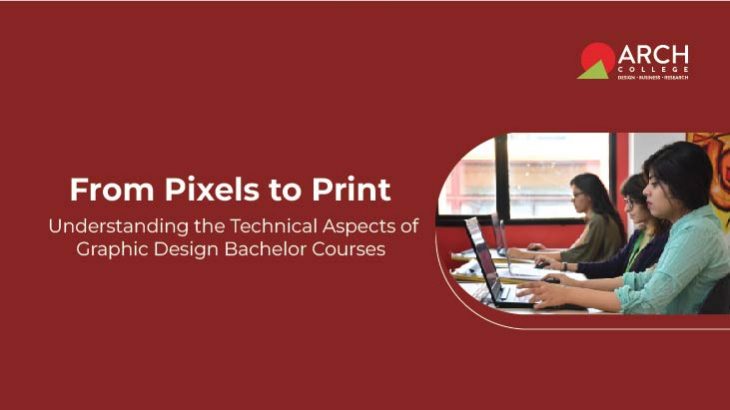Unlocking the secrets of graphic design mastery, get equipped with your curious and creative minds and dive in a world where creativity meets technical prowess!
With ARCH College of Design & Business, Graphic design becomes an exciting profession that mixes art, imagination & visualisation and knowledge of technology to show how thoughts, theories, and messages are meant to be communicated. With the need for competent graphic designers growing in many fields, getting a Bachelor’s Degree in Graphic Design or Design Communication is turning into a prominent decision for people who want to work as designers. This article discusses the technical aspects of the Graphic Design Bachelor programme. It looks at the most significant abilities, topics, and methods that students will learn about during their education.
A Brief Review on Bachelor’s Degrees in Graphic Design
Before we get into the comprehensive details, let’s talk about what Graphic Design Bachelor courses offer. Most of the time, these courses take three to four years and have a full syllabus that gives learners both academic and practical abilities. At ARCH, students learn more about design concepts, colour theory, formatting, layout development, and softwares that are used in the field. The technical elements of these lessons are very important for turning students into skilled designers who can meet the requirements of the design industry.
Key Skills Learned in Bachelor Courses in Graphic Design
- Visual Communication
Graphic designers tend to be visual speakers, and the skills they learn in ARCH’s courses is how to use visual features to get their ideas across. Learners acquire the ability to analyse their target groups, comprehend client descriptions, and turn ideas into designs that look good and get the point across.
- Design Principles
Graphic designers need to have a good grasp of design concepts. In courses, students learn how important arrangement, balance, order, contrast, and various other design components are for making designs that are interesting to look at.
- Colour Theory
One of the most important elements of Graphic Design Courses pertains to having knowledge about the colour psychology, colour ratios, and how numerous colours affect each other. Students at ARCH are taught to work with different colour models and make colour patterns that make people feel or say certain things.
- Typography
This is a very important aspect of graphic design. So that they can use typography successfully in their works, students learn about typefaces, font matching, readability, and ordering. They learn how to choose fonts that fit with the brand’s style and make the whole thing look better.
- Layout Design
A vital ability learned in Graphic Designing Courses is how to make plans for print and digital platforms that look attractive. Students learn how to use grids, borders, make use of white space, as well as additional aspects of layout to create a pleasing design that directs the viewer’s eye.
- Editing and playing with Images
Graphic designers need to know how to use tools for editing images thoroughly. Workshops often cover well-known software like Adobe Photoshop, where individuals learn how to enhance images, change them, fix their colours, and do additional significant editing tasks.
- Digital Design
With the growing digital world, graphic designers need to know how to make designs for platforms on the internet. Learners acquire the skills to make attractive and useful computer images, user interfaces (UI), and user experiences (UX). They learn about web design basics, flexible design, and how to make websites work best on various gadgets with distinctive screen sizes.
Graphic Design Bachelor Courses Cover a Range of Technical Topics
- Digital Imaging
This topic covers the technical elements of working with digital pictures, such as size, file types, colour modes, and optimising images for different means. ARCH Design faculty know how to handle and change pictures while keeping the best standards of quality.
- Print Design
It is important for graphic artists to understand the basic needs of print production. When creating for print, students learn about different printing methods, colour management, file preparation, and how important size and file format are.
- Web Design
Since webpages and other digital mediums are becoming more popular, web design is an important part of Graphic Design Bachelor programmes. Participants learn how to code in HTML and CSS. They also learn about flexible design, structuring, and modelling. They learn what expertise they need to make websites that look good and are easy to navigate and use.
- Motion Graphics
Motion Graphics deliver visual conversations a more alive feel. Learners learn how to make animated films, edit videos, and add motion graphics to different kinds of media. They know how to use time, changes, and graphic elements to improve the way a story is told by means of animation.
- Dynamic Design
Dynamic design is all about using dynamic features to make interactions with users that are fun and interesting. With ARCH, you’ll learn about interactive design concepts, how to test for usefulness, and development tools to make interfaces that are easy to use and experiences that are engaging.
Conclusion
Applicants who get a Bachelor’s Degree in Graphic Design with ARCH learn a wide range of competencies that include artistic vision, fundamental design concepts, and technical proficiency.
Here, they discover how to use tools and application used in the business, such as the Adobe Creative Suite, modelling equipment, motion graphics applications, and coding languages.
By learning about the technical aspects of Graphic Design courses taught here, prospective designers can effectively prepare for an outstanding career in the discipline of graphic design, which is always transforming!
